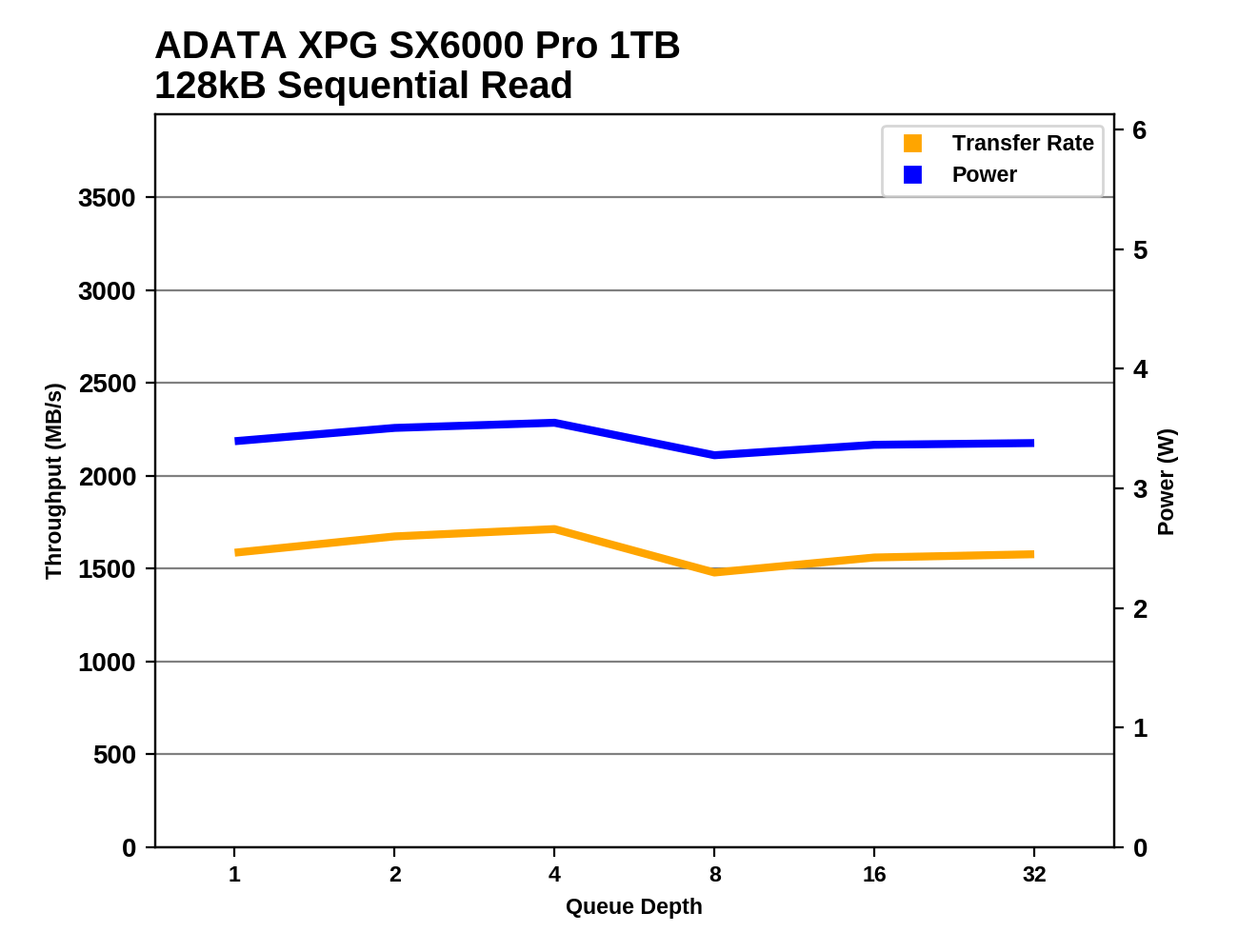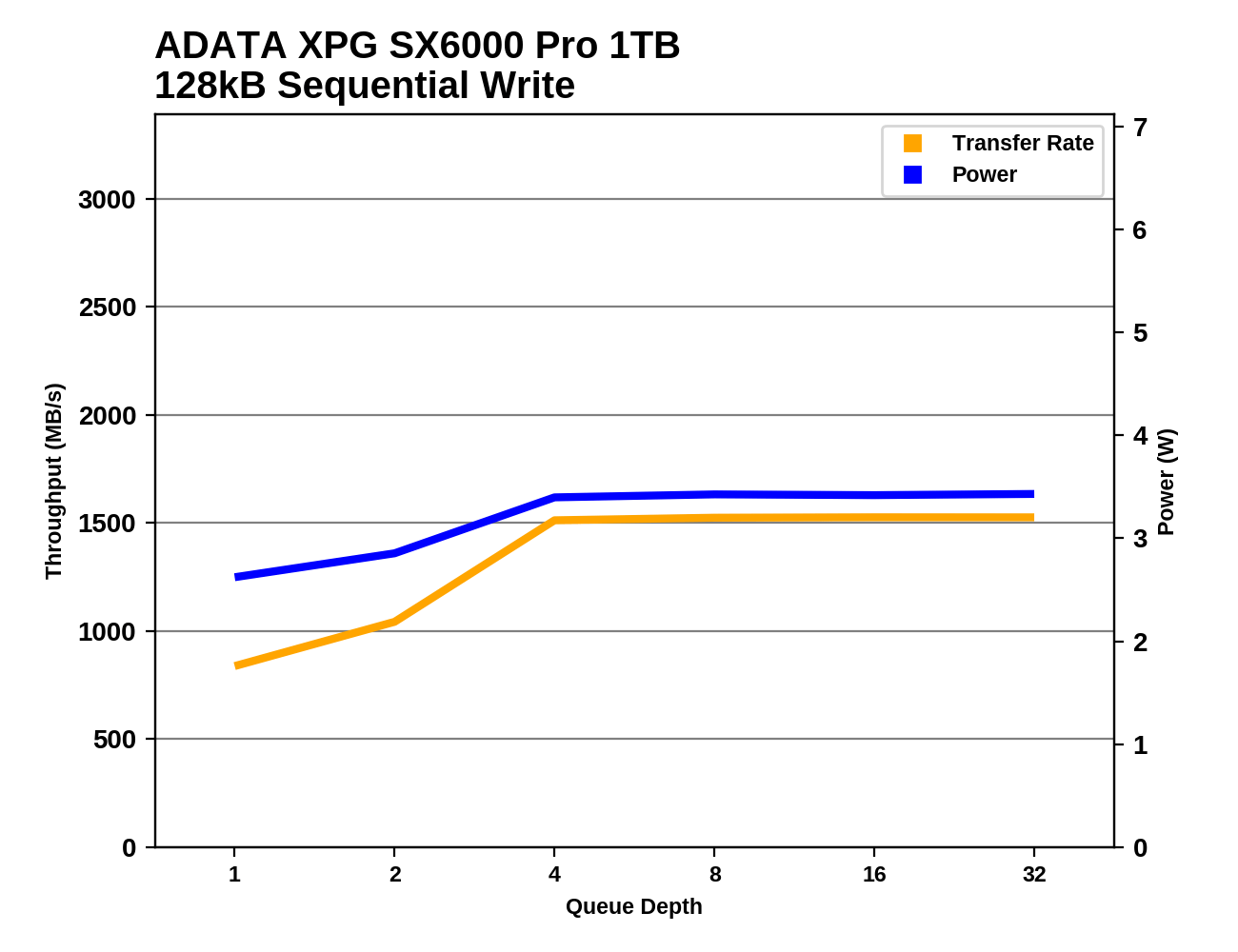The ADATA XPG SX6000 Pro 1TB SSD Review: Realtek's Entry-level NVMe Solution
by Billy Tallis on December 18, 2019 12:30 PM ESTSequential Read Performance
Our first test of sequential read performance uses short bursts of 128MB, issued as 128kB operations with no queuing. The test averages performance across eight bursts for a total of 1GB of data transferred from a drive containing 16GB of data. Between each burst the drive is given enough idle time to keep the overall duty cycle at 20%.

The burst sequential read performance of the ADATA XPG SX6000 Pro is comparable to other entry-level NVMe drives and some of the underperforming high-end drives. It is about three times the performance of SATA SSDs, and just over half the performance of the fastest high-end drives in this batch.
Our test of sustained sequential reads uses queue depths from 1 to 32, with the performance and power scores computed as the average of QD1, QD2 and QD4. Each queue depth is tested for up to one minute or 32GB transferred, from a drive containing 64GB of data. This test is run twice: once with the drive prepared by sequentially writing the test data, and again after the random write test has mixed things up, causing fragmentation inside the SSD that isn't visible to the OS. These two scores represent the two extremes of how the drive would perform under real-world usage, where wear leveling and modifications to some existing data will create some internal fragmentation that degrades performance, but usually not to the extent shown here.

On the longer sequential read test, the SX6000 Pro maintains its good standing. It's not in the top tier of high-end drives, but it is in the second tier that includes some high-end 8-channel+DRAM drives.
 |
|||||||||
| Power Efficiency in MB/s/W | Average Power in W | ||||||||
As usual, the power efficiency of the SX6000 Pro is poor, but for sequential reads it isn't the worst-scoring NVMe drive and it isn't too far below average.
 |
|||||||||
The sequential read performance of the SX6000 Pro dipped at QD8 and didn't fully recover before the end of the test, so even at high queue depths it doesn't attain the rated 2.1GB/s and instead is stuck closer to 1.5GB/s. The Mushkin Helix-L also showed a slight performance dip during the second half of the test, but it recovered and had no further trouble maintaining full speed.
Graphed against the whole database of results, the SX6000's power efficiency seems fairly middle of the road. The performance could have been achieved with a PCIe 3 x2 connection, but that's still pretty much par for entry level NVMe drives.
Sequential Write Performance
Our test of sequential write burst performance is structured identically to the sequential read burst performance test save for the direction of the data transfer. Each burst writes 128MB as 128kB operations issued at QD1, for a total of 1GB of data written to a drive containing 16GB of data.

The SX6000 Pro is by far the slowest NVMe drive on the burst sequential write test, only managing 1GB/s compared to 1.6GB/s or more for other entry-level NVMe drives.
Our test of sustained sequential writes is structured identically to our sustained sequential read test, save for the direction of the data transfers. Queue depths range from 1 to 32 and each queue depth is tested for up to one minute or 32GB, followed by up to one minute of idle time for the drive to cool off and perform garbage collection. The test is confined to a 64GB span of the drive.

On the longer sequential write test that also includes some higher queue depths, the SX6000 Pro's score improves slightly, while the other low-end NVMe drives slow down a bit due to the higher volume of writes in this test. There's still a substantial gap between the SX6000 Pro and the rest of the NVMe drives, but it's much smaller than the SX6000 Pro's lead over SATA SSDs.
 |
|||||||||
| Power Efficiency in MB/s/W | Average Power in W | ||||||||
The SX6000 Pro is tied for worst power efficiency among these NVMe SSDs, but it's still providing twice the performance per Watt of a SATA drive. The other two DRAMless NVMe drives take the top two spots for power efficiency on this test.
 |
|||||||||
The SX6000 Pro doesn't hit its full sequential write speed until QD4, while the Mushkin Helix-L and Toshiba BG4 both saturate at QD2, and the BG4 has a clear speed advantage at full speed. The ADATA SU750 didn't manage to reach full speed until QD8, so clearly Realtek's NVMe controller has some advantages over their SATA controller.
As with sequential reads, the power efficiency of the SX6000 Pro doesn't look too bad when graphed against our entire library of SSDs, but there's definitely room for improvement. At high enough queue depths, the performance gets up to near the same levels that most entry-level or outdated high-end NVMe drives offer, and the drives that are substantially faster are mostly high-end models from the past one or two generations.












36 Comments
View All Comments
Billy Tallis - Wednesday, December 18, 2019 - link
My mindset is that your complaint isn't specific to the SX6000P; it's true of the entire category of "low-end NVMe" drives, so I don't want to single out the SX6000P for suffering from the same problem that all of its closest competitors also suffer from. It's halfway-decent at what it's trying to be, but it's trying to compete in a niche that barely exists in the first place.At least for the retail SSD market. The most popular retail NVMe SSDs are all high-end drives, so they get economies of scale that the low-end models don't, and that's why E12 and SM2262 drives can be priced so close to low-end NVMe. But in the OEM market, low-end NVMe drives do have a more compelling value proposition, and that's where the controller vendors make the real money.
That in turn influences what kind of drive designs the SSD vendors have on hand to readily convert into a retail product. The best example of this is the WD Blue SN500/SN550 series, which existed as an OEM product for a year before it came to retail. There's also Toshiba's BG series, which has been through four generations and they only bothered to do a retail release of one of them.
Great_Scott - Wednesday, December 18, 2019 - link
The SSD market is and has been monstrously compressed.The difference between performance tiers for SATA is frequently $10/tier. (excepting the occasional Samsung drive.)
I don't see that anything is substantially different for NVMe. This is a good, maybe great, budget drive. The problem being that you can spend $10 for a far better one.
At some point in the future where price isn't entirely dictated by Flash BoM this might change, but for now it only makes sense to get the best drive in a category since they all cost about the same.
Freeb!rd - Thursday, December 19, 2019 - link
My thoughts also... I was looking at NVMe Gen4x4 drives at around $200 for 1TB, but then saw the EVO 970 Plus was out performing them, almost bought that on Monday for $199, but saw a Sabrient Gen4 for $168 with $11 coupon on Amazon and went with that... NOW Amazon has the EVO 970 Plus for $169... which ever way the wind blows is the best value it seems. Although, Amazon has those "morphing" prices that seem to change often, probably based on your search habits. $169 for the EVO 970 Plus 1TB vs. $539 for the 2TB? Maybe Amazon tells vendors where the majority of sales volume is coming (ie 1TB) and competitors are getting more sales through via a certain price and miraculously the Samsung EVO price drops to match in a few days!! I'm sure Amazon analytics provided to their vendors play a part, probably be back to $239 after Xmas.Freeb!rd - Thursday, December 19, 2019 - link
FYI, so the Sabrient Gen4 was $157.xx after coupon, still a great deal on a Gen4x4 drive for my new X570 motherboard.HarryVoyager - Thursday, December 19, 2019 - link
The pricing is what makes all of this somewhat nuts. When I rebuilt my machine a month or so ago I ended up going with the 660p because I could get the 2TB version for around $170.While it isn't near the top of the heap for the destroyer, I don't do transfers of much more than a few GB at a time, and those are limited more by my Internet connection than by the drive.
I've also got a professional grade SATA SSD, and despite its synthetic benchmarks being an order of magnitude lower than the 660p, I honestly can't tell a difference between what's installed on which. And I'm a heavy gamer who runs stuff that is notorious for slow load times and heavy RAM usuage. Even there, I'm not usually pulling more that 20Gb of data in a set, so it's just not a big difference.
dragosmp - Thursday, December 19, 2019 - link
QLC was supposed to help with this segmentation. Hard to make a low end drive much cheaper just by not adding a 2$ DRAM chip and some PCB traces.Crucial P1 tends to kinda fulfill the QLC promise. It is sometimes at or around 80$ on offer for 1TB, has good warranty and performs quite well:
https://www.anandtech.com/bench/product/2533?vs=22...
tlmiller76 - Saturday, December 21, 2019 - link
I gotta disagree with the P1. I have one (1TB), and to be honest, I hate it. It's just...garbage in every way. I actually HAD an SX6000 Pro 1TB (unfortunately forgot to swap it out before I sold the laptop it was in) and it was so much better than the P1 they weren't even in the same zip code.zmatt - Saturday, December 21, 2019 - link
IMO low end NVMe drives aren't worth considering at all. If you dont have the money for a Samsung Evo then dont both because you aren't really seeing the benefits. Obviously this doesn't apply in the case of a laptop or SFF where you may not have a choice.TheUnhandledException - Wednesday, December 18, 2019 - link
It would be nice is low end NVMe drives were significantly cheaper but at least right now they are not. I don't really see the rationale for paying 2% less and getting 40% lower performance.sean8102 - Monday, February 3, 2020 - link
I upgraded from a 256GB SATA Samsung 840 Pro (my first SSD ever) to the HP EX 920 1TB and love it. Never thought I'd end up going with a HP SSD but their EX 9x0 product line is great. Thinking of getting another NVME drive just for games and going with the EX 950.